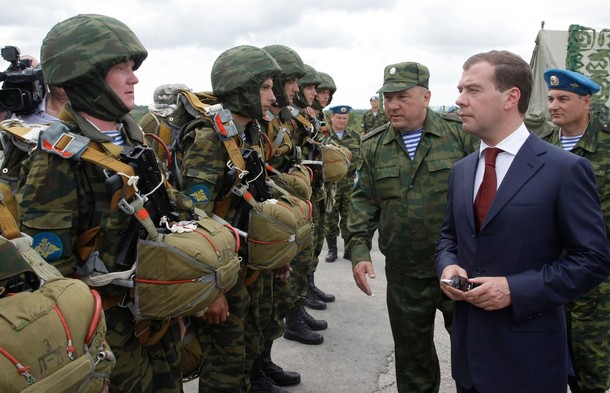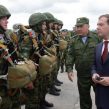
The Russian Military Concentration in the Caucasus
Publication: Eurasia Daily Monitor Volume: 6 Issue: 136
By:

After visiting breakaway South Ossetia on July 13 and Russian troops based deep inside Georgia, President Dmitry Medvedev traveled to Novorossiysk to inspect Russia’s main deepwater Black Sea port and nearby military facilities. Medvedev visited the Black Sea fleet flagship cruiser Moskva, attended a meeting of the military top brass and inspected troops in the 7th airborne (VDV) division based in Novorossiysk (RIA Novosti, July 14).
In South Ossetia Medvedev visited the Russian military HQ and base in Tskhinvali. He was then taken by helicopter from Tskhinvali to Akhalgory – a part of former Soviet autonomous South Ossetia that was inhabited by ethnic Georgians and was never under the control of Ossetian separatists. In the aftermath of the Russian invasion last August, Ossetian militias expelled most of the Akhalgori population. Akhalgori is only several miles of relatively good road from the Georgian capital Tbilisi, while a very bad dirt track hastily built by the Russian military connects Akhalgori to Tskhinvali. Akhalgori, which the Ossetians and Russians call Leningori, is a major forward Russian military base from where its tanks could swiftly roll into Tbilisi. Medvedev was accompanied to Tskhinvali by a large group of Russian journalists, but he went without them to Akhalgori (Kommersant, July 14). Medvedev later announced that Russian armor and military bases in South Ossetia are "a serious structure" and "this is a direct signal to those who get the itching and who get idiotic plans in their heads from time to time" (ITAR-TASS, July 13). It was clear that Medvedev’s invective was aimed at Georgia.
In Novorossiysk Medvedev attended a meeting of the top brass together with the Defense Minister Anatoly Serdyukov and his first deputy the Chief of the General Staff Army-General Nikolai Makarov. They assessed the results of the massive military exercises Kavkaz-2009 that began on June 29 and officially ended on July 6. Kavkaz-2009 involved Russian air, army and naval forces and were deployed on Georgia’s borders as well as in occupied Abkhazia and South Ossetia (EDM, June 18).
In a statement at the military meeting, Medvedev issued more warnings aimed at Georgia and its President Mikheil Saakashvili. "I would not like to specially recount what happened last year and what we encountered and were forced to give a tough, but pretty effective response," stated Medvedev, "I hope this lesson will be well remembered by those who are trying to reshape the current order and solve their personal problems by violence." Medvedev added, "To us the main lesson of these events is the need to hold constant, massive and highly effective military exercises in all the branches of our armed forces" (RIA Novosti, July 14). Russian officials and the media have frequently accused Georgia of planning a new "revenge" attack on Abkhazia and South Ossetia (EDM, June 25). It is clear that Moscow is ready to meet any provocation with a crushing blow.
The 7th VDV division paratroopers and the Moskva cruiser were involved in Kavkaz-2009. Medvedev was shown advanced paratroop battlefield equipment and was apparently surprised to learn that a Russian paratroopers’ full battle gear weighs 40 to 60 kilos. Medvedev asked the soldiers if this was too heavy and they replied saying, "normalno" or "okay" (RIA Novosti, July 14). The battle equipment in the Russian military is indeed extremely outdated and heavy. The defense ministry recently boasted about the VDV’s newest field communications and laptop equipped with GPS, Wi-Fi and video camera that weighs 20 kilos including its battery (RIA Novosti, July 7).
During Medvedev’s visit to the Moskva, it was announced that Russia will press ahead with building a base for the Black Sea fleet at Novorossiysk that will be operational after 2016 and will house up to 90 ships including new submarines. A base for the Black Sea marine unit will be built at Temryuk – a port on the Azov Sea north of Novorossiysk. In 2017, the Russian lease of the Sevastopol base in Crimea, Ukraine will expire. Russia wants to preserve Sevastopol, but the present Ukrainian government insists that the Black Sea fleet must leave. Makarov told journalists in Novorossiysk that the Russian military has no intention of leaving Sevastopol, but it must be prepared to meet any eventuality (RIA Novosti, July 14).
In July 2008, the Black Sea fleet lead by its flagship Moskva took part in the Kavkaz-2008 exercises that were a prelude to the war with Georgia in August. The Black Sea fleet marines landed in Abkhazia and invaded Georgia together with the Russian army while the naval force blockaded the Georgian shore. But the fleet could not use Sevastopol as an operational base, because of Ukraine’s friendly relations with Georgia. Moskva and the naval task force had to spend months out at sea. The marine force was moved out in advance from Crimea to the North Caucasus together with landing craft. This year the Moskva was again deployed to the South Caucasus shore and anchored in the Novorossiysk bay when Medvedev visited – there is no proper Russian port in the region to dock.
The Black Sea fleet is currently the only Russian naval force with combat experience, but it cannot go into battle direct from its home base in Sevastopol. If in the future, in 2017 or before, Russia’s claim to have special rights and interests in Crimea leads to a military confrontation with Ukraine, the Black Sea fleet might be militarily defenseless or at a serious disadvantage in its Sevastopol base in any possible confrontation with the Ukrainian ground forces. To effectively reclaim Sevastopol militarily, Russia must first move out its combat-ready ships. Russia may long to keep Sevastopol, but at present it urgently needs another good operational Black Sea base to act against Georgia and an extended facility to house most of the Black Sea fleet with reinforcements on its Caucasian shore to be ready for any possible standoff over Sevastopol and Crimea.




